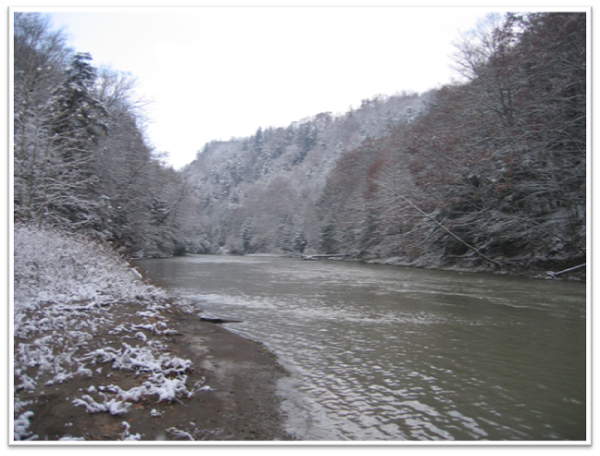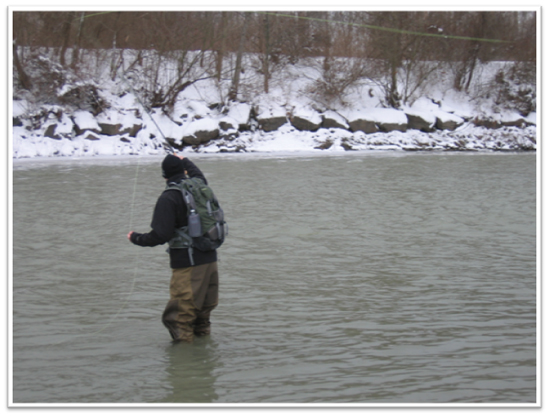
Cattaraugus Steelhead
ARTICLE BY INDREK KONGATS, DECEMBER 5, 2017

One of the advantages of living close to one of the best steelhead rivers in the east, the Cattaraugus Creek, is that when the opportunity presents itself and the conditions are ideal, you can grab your rod and waders and on a moment’s notice, off you go. Most people don’t think of fly fishing in the middle of January, but with no closed season, the steelhead are just waiting for someone to catch them.
Most steelhead enter the river in the fall and will stay in the river until spring; when you hook these fish, they will be darker in color. If you hook an explosive shiny silver fish, it will most likely be a fresh fish— these silver bullets will continue entering throughout the winter and into the spring.
The trick to winter steelhead fishing is to keep a close eye on the river— in particular, the water temperature, ice build up along the banks and water levels. All three of these elements are critical in finding and safely catching winter steelhead.
Our typical January thaw usually brings warm temperatures and abundant rainfall; this helps clear the ice from the banks and warms up the water temperatures. After a few days of clear and sunny weather, the river levels will drop, the water will clear and the perfect steelhead conditions will exist. The ideal water temperature is somewhere between 40 and 50 degrees Fahrenheit, but you will catch fish below 40 if you slow down your presentation and fish deeper. Air temperatures can be much lower, even down to the teens, if your fingers can bear it. Stripping in your line in freezing temperatures will freeze up your rod guides, so you’ll have to either remove the ice between casts by dipping your rod into the water to thaw it out, or simply use a cooking spray on your guides to keep them de-iced. 
An important point to remember when wading in and around the river in the winter months, and even into the spring, is not to use felt-soled waders. Walking in snow with felt soles will be difficult, uncomfortable and possibly dangerous, as the snow will attach to the felt and build up like a big snowball. The soles will also freeze and will slip on ice and smooth river bottoms and rocks. The ideal sole is one that is made of rubber to which you can screw steel studs into. A wading staff is also a critical safety tool; you don’t want to take an unexpected dip into icy water or stumble in deep snow drift.
The best fly line for winter conditions is a weight forward sink tip cold water trout line that allows you to fish well under the surface while still mending your line on the surface. Since most of the fish that you will catch are in the 6-10 pound range, a 5-7 weight fly rod and line combination is ideal. The length of the rod is also important, as is the length of the sinking portion of the fly line.
To properly mend the floating portion of the fly line, a 9- or 10-feet rod length is minimal. The sink tip portion of the line should be 12 to 15 feet so that when you dead drift or swing the fly, it will be bouncing across the bottom where winter steelhead hang out.
Selecting the fly for winter steelheading is dependent on the water temperature and the water clarity the day that you venture out. The fly selection will also be dictated by the fly fishing technique that you will be using, swing or dead drift. In order to dead drift a fly, you will need to cast your fly slightly up and across the river. As the fly line drifts back towards you, you will need to pick it up off the water to prevent it from catching the surface current and dragging the fly faster than the fly is bouncing along the bottom. As the fly continues past you, you have to let out the fly line and mend it out to where the fly is drifting. The term “dead drift” means that the fly is naturally bouncing along the bottom ahead of the fly line without any pull or resistance. 
Swinging the fly in the winter months requires the angler to cast up and across as if dead drifting, when the fly drifts past you, instead of feeding out more line, the angler holds the line tight causing the fly to swing across the current to dangle directly below you. If the water is in the higher temperature range, this technique will be the key to catching active and aggressive fish.
In both techniques, the angler has to be focused on a possible strike while dead drifting. This could be as slight as a hesitation in the drifting fly line, almost like a brief bottom snag; set the hook immediately by lifting the rod. There is no mistaking the strike on the swing— just remember to hold onto your rod, no hook set is necessary.
For dead drifting, a simple egg pattern fly is ideal in orange or black or a combination of the two. Tie a fly on a number 8 or 10 size heavy wire grub hook. Begin by wrapping some lead wire around the shaft of the hook and then simply wrap some florescent orange Angora goat dubbing material over it until you have a nice, fat-looking fly. That is all you really need for an excellent dead drift fly. The lead underbody, coupled with the heavy gauge hook, will sink the fly quickly. The swing fly can also be weighted, but the best color is black and should resemble more of a bait fish or leech. The popular choice for a winter swing fly is the woolly bugger tied on a 2 or 4 size streamer hook. The black fly creates a very noticeable silhouette that the fish can’t miss and the marabou tail of the bugger gives it life through undulating movements.
The final and most important tip for winter steelhead fly fishing is to use a very short fluorocarbon leader no more than three feet in length. This will help deep the fly close to the bottom and being fluorocarbon, it is invisible under water and won’t spook the fish. Good luck and good fishing!
back to main menu

|